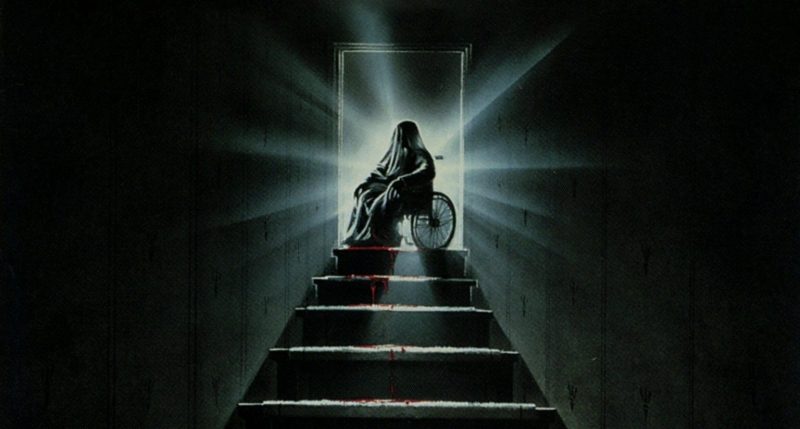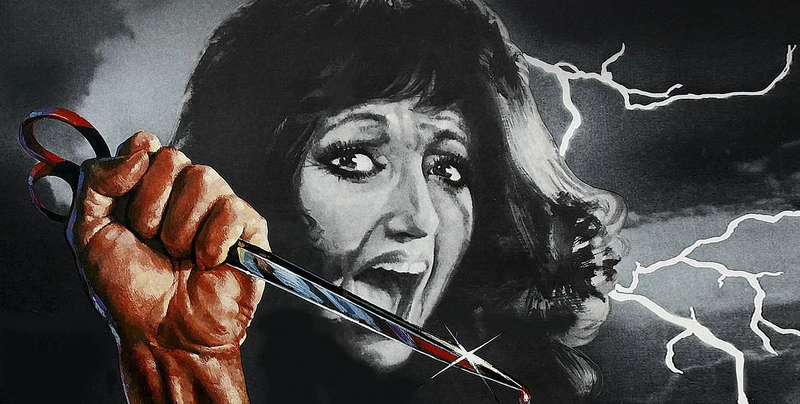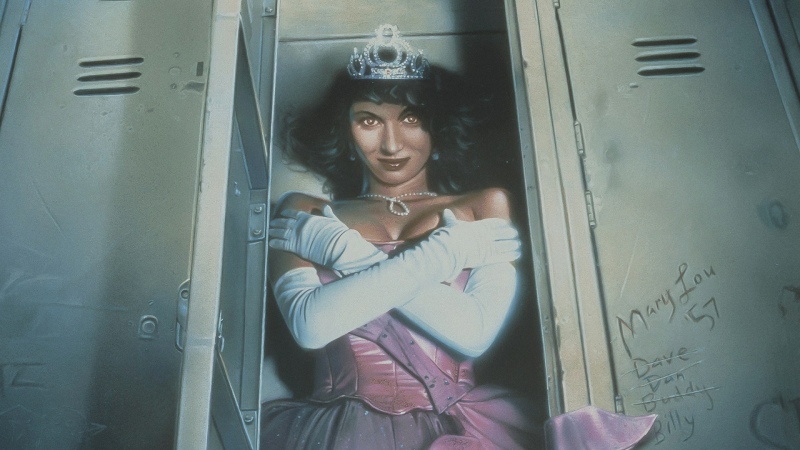
Director: Sam Firstenberg
18 | 1h 32min | Action, Fantasy, Thriller
God bless you Cannon Group; I mean, truly. I’m convinced that if a handful of the world’s greatest comedy directors were locked in a room together, years later they’d still have failed to produce something as delightfully absurd as Ninja III: The Domination, Sam Firstenberg’s crème de la crème of crap movies. Put succinctly, the film is a heady blend of Flashdance, The Exorcist and Firstenberg’s previous outing Revenge of the Ninja, both films belonging to a so-called trilogy that also includes Mehahem Golan’s Enter the Ninja. I write ‘so-called’ because those movies have absolutely no narrative connection. The only thing they have in common, barring the appearance of ninjas, is the fact that they each star cult ninjutsu practitioner Sho Kosugi, an actor Cannon would establish on western shores, and who in turn helped spark the VHS ninja craze of the early 1980s.
In true Golan-Globus fashion, Ninja III: The Domination attempts to cram every mid-80s cultural fad into an organic blender — the kind you’d find sputtering to a halt in the Peltzer family kitchen — tapping into the MTV revolution, Jane Fonda aerobics, and even the home video horror boom. Not that you’d be able to tell from its title, but Ninja III: The Domination is as much a horror movie as it is a martial arts flick, delivering awe-inducing scenes of ham-fisted terror that border on Zucker/Abrahams/Zucker territory. It’s a damn fine comedy if you’re the kind of film nut who can appreciate such unadulterated drivel, leaping from one absurd scenario to the next with a dissonance that will make your eyes pop. Incidentally, a more suitable title would have been ‘Ninja III: The Possession’. Just saying…
Cannon honchos Menahem Golan and Yoram Globus would purchase Cannon Films at the turn of the 80s, transforming it from a struggling independent production company into a home video player thanks to a savvy business model of buying mostly bottom-rung scripts and turning them into B-grade gold. So erratic was their process, so relentless their output that the duo would often sell movies based on a title and an accompanying promotional poster. The fact that they had no actors, no plot, no dialogue, no diggity, was of little concern. These peripheral elements were usually made up on the fly, the reason why the likes of Ninja III: The Domination poofed into existence like a ninja-concealing smoke bomb.

The movie starts as it means to go on — with the infamous golf course massacre. A mysterious man enters a mysterious cave and descends a staircase to a sacred tomb. Within the sacred tomb are mystical age-old weapons bathed in a mysterious golden light. Next to this cave is an exclusive, members only golf course. Makes perfect planning sense, right? Why the man decides to slaughter the affluent members of a golf club is never explained. Is he a disgruntled conservationist miffed at their ruthless privatisation of the Earth? Probably not, since he arrives in a pollutive sports car decked out in shades and a white Miami Vice suit. My guess is the golf course and its rocky surroundings were a convenient location, golfers the only logical victims. And you best get used to convenience if you’re to survive this one. Convenience is this movie’s lifeblood.
More convenience comes in the form of a telephone repair lady-come-part-time aerobics instructor who just happens to witness what is undoubtedly the largest single killing spree via hand-to-hand combat ever perpetrated in the United States of America, an act made possible by the fact that what appears to be the entire Greater Los Angles police force, who must have been attending a nearby party that dragged on into the early hours given the time of day, arrive within the blink of an eye. It wouldn’t surprise me. California’s finest are always slacking off it seems, chomping cigars, chugging down beers and generally getting their rocks off at all hours of the day. Later, some of the surviving cops pop out while on duty to canoodle with some naked harlots at a nearby spa. Those same cops are responsible for the Black Ninja’s death following a truly relentless bloodbath of slashed torsos and shuriken impalments, which spells disaster after protagonist Christie Ryder is possessed by the ninja’s spirit, something made apparent by a quite spectacular windswept perm.
What makes Cannon’s most ridiculous movies so special ― and believe me, Ninja III: The Domination is a contender for the absolute zaniest ― is Menahem Golan’s insouciant, almost childlike approach to producing. In the case of Ninja III: The Domination, there’s also the issue of deleted scenes, which, due to rights issues (different cuts were released in various regions due to censorship issues), are yet to be reinserted or even included in subsequent releases as the film inevitably garnered a huge cult following. Those scenes supposedly include an extended backstory, but knowing Cannon there’s no guarantee that the film will make any more sense in its complete, intended form. Quite frankly, I wouldn’t want it to. Its beauty lies in its dissonance, both narratively and from a production standpoint.

Ninja III: The Domination was rushed into production to capitalise on the unexpected success of Firstenberg’s Revenge of the Ninja, which thanks to America’s growing obsession with ninjas managed a not-too-shabby domestic gross of $13,168,027 on a budget of only $700,000. Any other producer would have simply demanded more of the same. Not Menahem Golan, who for whatever reason refused to recast Sho Kosugi as the sequel’s marquee star, partially due to the fact that he was determined to further Americanise Cannon Films, creating stars like Michael Dudikoff and Steve James for Firstenberg’s American Ninja series, films which laid out the producer’s intentions in no uncertain terms. There was, however, a silver lining. Ultimately, it was Golan’s peculiar decision to relegate the hugely popular Kosugi that resulted in arguably the strangest ninja movie ever committed to celluloid. Period.
“So Menahem Golan calls me in and says, ‘We are going to make a sequel. But I don’t want Sho Kosugi as the star anymore’,” Firstenberg would recall. “…I don’t know why. I still don’t know why. I don’t know if it was something personal between them. Or if it was a marketing decision… So Menahem Golan came up with the idea: why don’t we make [our third ninja movie] with a female ninja—with an actress? I said, “Okay, that’s a good challenge. I’m your director. [This movie] is not my personal statement.” It’s a craft and I do whatever needs to be done. Like in the golden age of Hollywood, the director had very little to say about a movie… …Sho Kosugi was infuriated. He was devastated. He didn’t understand why, suddenly, he is not the star after such a successful movie. And he felt that a woman taking his place—a woman ninja—was unheard of. So Sho Kosugi was seriously against [taking a backseat to Lucinda Dickey]. There were arguments and fighting. And Menahem Golan didn’t know how to resolve it and kind of threw it into my lap and [the lap of] the writer and he said, “You [two] resolve it.“
Despite Golan’s hegemonic personality and unwavering business logic — or lack thereof — it was actually Firstenberg, taking inspiration from Tobe Hooper’s, Spielberg-backed horror-through-appliances smash Poltergeist, who suggested the whole possession angle, something that allowed Kosugi to play the movie’s hero despite receiving second billing. In the film, Kosugi plays Goro Yamada, a mysterious, eyepatch-sporting ninja warrior looking to avenge David Chung’s ‘Black Ninja’ Hanjuro for killing his sensei, a task that isn’t quite as simple as it sounds. Convoluted plots and uneven characterisation will do that to you.

Christie is played by Cannon go-to girl Lucinda Dickey of Breakin’ fame, her casting as the movie’s stealth assassin an inspired turn of against-type absurdity. When she’s not slicing and dicing she’s flaunting her spandex excesses, fighting off gangs of rapists so transparent they actually attend her classes, cornering her in an alley in front of a whole group of witnesses. Not that she does herself any favours, seducing veritable strangers by pouring V8 tomato juice all over her chest in a seriously hip apartment that looks like an 80s arcade-come-pop music video. Christie is an almost carbon-copy of Jennifer Beals’ Alex from Flashdance, the Oscar-winning, MTV-inspired hit released a year prior. Instead of a “steel town girl” who dreams of ditching her welding job for life as a professional ballet dancer, we get a pseudo-serial killer who spends her time marvelling at levitating swords in a fugue state or being attacked by a laser-shooting arcade machine that also seems to harbour the power of possession.
“In the movie business there is something that is called ‘product placement,’ you know?” Firstenberg would say when quizzed about yet another nonsensical plot development, confirming Cannon’s seemingly relentless knack of exploiting popular trends, something that makes Ninja III: The Domination an exquisite time capsule for fans of 80s kitsch. “They’re a promotion gimmick. The advertising company gives the product to the production. And they’re supposed to put it in the movie. For example, V8 gave us tons and tons of V8 for the production. And this also happened with the video game machine. The arcade game was called “Bouncer.” And I found out recently there’s a following for Bouncer… an arcade game that never came out... And remember: in Poltergeist, the spirit comes out of the television. I didn’t want to be so bold and copy everything in Poltergeist; so I said: okay, never mind, no television; but game machine. So it copies the idea from Poltergeist, but not 100%. And we got this game as a product placement… that’s how it ended up in the movie that the spirit comes from the game machine. Not always. Sometimes it comes out of the closet. But part of it was: okay, let’s do the laser…and laser effects were kind of a novel idea at the time…it was an “in” thing. So that’s how it was incorporated into the story.“
The fact that outside promotional forces, their products shoehorned in with the subtlety of a neon green ninja, determine the plot to some extent, makes for truly irregular viewing, but even stripped of such priceless quirks, Ninja III: The Domination is a seriously zany experience. Plot developments are so heedless, relationship arcs so misguided it’s positively stunning, shifts in character integrity fly kicking you in the back of the head from out of nowhere. Remember those puerile revenge scenarios cooked up on the school playground while play-fighting with your friends? You will after watching this movie. Characterisation is so ill-defined that, despite being scant, it’s also weirdly complex, as if characters are suffering from multiple personality disorder. During an interaction, a character can go from odious, aggressive and selfish, to kind, caring and selfless. Sometimes you wonder if the entire cast is possessed along with our increasingly volatile protagonist.

Interestingly, Ninja III: The Domination, released four months after Breakin’, was actually Dickey’s first Cannon movie, the shoot for the latter commencing immediately after the former had wrapped. This was again precipitated by Golan-Globus’ insatiable thirst for tapping into popular trends, the duo doing everything in their power to beat Orion’s Beat Street, another breakdancing-themed movie, into theatres, which they did by a whole month. So ruthless were the Israeli duo that they began promoting a Breakin’ sequel through a Variety ad, again without a script or even a treatment to their name, before Beat Street had even made it into theatres, rendering a movie that was much more authentic and attuned to the breakdancing revolution commercially obsolete.
Christie’s love interest arrives in the form of the film’s most contradictory character, a sleazy sex pest who ultimately has our troubled heroine’s best interests at heart. While Jordan Bennett’s officer Billy Secord is technically paper-thin filler, his spurious, often mindboggling actions make for arguably the most intriguing character in Ninja III: The Domination. Secord first gets his claws into Christie by harassing her at the station following the most traumatic experience of her young life, asking her out for coffee, dinner, even CANDY in his attempts to woo her. Now that’s creepy!
Unperturbed by Christie’s reluctance, Secord swipes her number from the precinct and gives her a call. He then turns up at one of her aerobics classes, arresting her as a bargaining chip to get into her pants. When that doesn’t work, he threatens to throw her out of his car and abandon her in the middle of nowhere. Not the smoothest approach one would assume, but in the world of Golan-Globus, Secord is a veritable James Bond, a slick stud so skilled in the art of seduction that Christie is putty in his hands. Rather than file a restraining order, she falls madly and deeply in love with the unconscionable pig in a matter of seconds. So what we essentially have is an empowered heroine creaming under the thumb of chauvinistic oppression. To say this film is ethically confused is a gross understatement.

What Billy doesn’t realise (I mean, why would he?) is that Christie is leading a double life of murderous vengeance, quickly becoming the physical force of a relationship that borders on female domestic violence. Soon enough she’s experiencing headaches and memory loss as the dead cops, Billy’s friends, continue to pile up. The fact that Billy never seems to be on duty — yet another narrative convenience — may explain his gross professional ineptitude. Billy is absolutely oblivious to Christie’s murderous extravagances, despite a plethora of clues, so much that when his new squeeze returns home with a cache of deadly weapons and unexplained injuries, our vacuous officer is still unable to put two and two together, sending Christie to a psychiatrist who finds nothing out of the ordinary except for her “exceptional extra-sensory perception and preoccupation with Japanese culture.” A little on the nose, don’t you think?
Though he’s witnessed nothing even remotely supernatural, snoring through glorious, neon-laced bouts of possession, Billy then suggests that Christie see a Japanese spiritualist recommended to him by a cop buddy in the famous Asiatic Division — Please! — and his main squeeze reluctantly agrees, leading to a priceless exorcism that makes Leslie Nielsen’s lowbrow spoof Repossessed look like Linda Blair’s darkest hour, exorcist Miyashima’s cod-philosophical madness enough to reveal all to everyone except the film’s utterly perplexed audience.
Once the Black Ninja’s spirit is extricated from the body of our clueless heroine, it’s Kosugi’s time to shine, though thanks to the Motion Picture Association of America, the film’s more explicit moments were nixed from the US theatrical cut. The movie’s fight sequences are still fairly impressive, Kosugi and Chung treating us to some spectacular moments of high-kickery, but the omission of blood and guts certainly detracts from the film’s horror elements.

“In the ninja movies that I directed, they were violent… I was very impressed by samurai movies. And those movies are extremely violent… decapitations and cutting into the heart and stuff… I wanted to copy this kind of violence. Poetic violence,” Firstenberg would recall. “Now, of course, in America you have the committee that gives the ratings. And we, as a small company, did not have enough… influence or power… the studios had more power to press them because they financed them. And their job is to criticize. And in Ninja III: The Domination, there was some graphic stuff. Decapitations. Rolling heads. I don’t remember the specifics, but we had to cut out some stuff for the theatrical version. So every time we finished a movie, we sent it to the MPAA and we got [an X rating]’. Always.”
According to an audio commentary featured on the Shout Factory Blu-Ray release, the Cannon Group believed that a 90-minute action movie should have at least 45 minutes of action sequences, so you can probably imagine the extent of the mayhem on display, and a production company renown for its financial fluctuations are nothing if not resourceful. One incredible act of cost-cutting saw stunt coordinator Steve Lambert play an incredible 37 parts during the opening golf massacre alone, the grounds for the greatest game of ‘I Spy’ there ever was. If I could travel back in time, landing a job as a crew member for Golan-Globus during the mid-1980s would be right up there on my list of priorities.
Like all cinematic absurdities, Ninja III: The Domination leaves us with many unanswered questions: How does a woman leave a police station with a murder weapon like a samurai sword? How does a ninja summon the power to crush a golf ball in the palm of his hand, and why does it turn to dust instead of elastic bands coated with plastic? If a woman kills an entire police force while possessed by the spirit of an evil ninja, can she still be prosecuted in a court of law? As demons fly around the place and ninjas disappear under the earth only to spiral back into life like an undead tornado, you quickly begin to realise these are the kind of questions that will never be answered, but boy will you have fun contemplating them!
Bad Landing
The sheer repugnance of the town’s police force is something to behold. These are men who have a duty to protect and serve, but instead they’re vulgar, misogynistic scumbags who are absolutely dripping with sleaze.
One of the film’s most satisfying and implausible moments comes when Billy’s Cigar-chomping colleague, Jimenez (Ron Foster), is tracked down at his apartment and launched through a ground floor window, falling an entire foot to his death.
You better have a head for heights.
Crazy Golf
The unrelenting absurdity of the golf course massacre has to qualify as one of the most astonishing openings in B-movie history. In terms of action, it’s playground cops and robbers at best, but the sheer scope of the carnage is truly astonishing, and somewhat baffling.
How has the Black Ninja’s tomb of weapons gone undiscovered for so long? How does a person summon the power to lift a golf buggy with one hand? Why does a dart, blown through the barrel of a gun, somehow cause it to explode?
One can’t begin to understand.
Hand Me That, Will You…
Scenes in which Christie is possessed by the Black Ninja’s spirit have to be seen to be believed.
The whole exorcism debacle is priceless cult cinema and then some, complete with blood-red contacts, shoddy lightning effects and the kind of horrible dubbing that even Italian genre cinema would scoff at, particularly when Christie mimes along to throaty Japanese demons.
Just as priceless is a possession scene that takes place in Christie’s bedroom, one that treats us to the jaw-droppingly kitsch moment when the Black Ninja’s aluminium samurai sword, aglow with neon, hovers across the room towards its new master, thanks initially to an unseen stagehand who passes the item from inside a wardrobe and then to a barely visible wire.
Just glorious!
Look What She Did, Your Cunting Ninja
There are unexpected developments and there are unexpected developments… Guess which category this one falls into…
Having finally agreed to consult with spiritualist Miyashima, Christie is asked to wear a dog collar and wrist chains, equipment designed to restrain her while she undergoes a quite preposterous exorcism. Moments later, our protagonist gets the Linda Blair treatment, performing a whirlwind of pseudo-acrobatics in what is little more than a sadomasochist’s lair.
Naturally, Christie is a little concerned by the restraining apparatus, clinging to her misogynistic beau and waiting hopelessly for advice. Cue Billy, with the kind of tone one might use to persuade an infant to sample their broccoli.
Billy: C’mon! Give them a chance.
So small minded!
Blending action, romantic comedy and supernatural horror, as an exercise in the wonderfully absurd
Edison Smithwill make your head spin around 360 degrees ― unless, of course, you happen to be in possession of a rather sturdy, fetishistic dog collar. As a bad movie enthusiast, I’ve seen some pretty incredible things in my time, but in the realms of out-there genre mashes, this one takes some beating.







































Oh yes, yes, yes, yes (I’ll have what this film’s having…which is everything)! Crushed golf balls, V8 juice, swords on a string, aerobics, possession, hairy backs, pervy guys in hot tubs, intense eyes, James Hong…wow. I viewed this film as a kid and loved it, but I didn’t realize at the time how full tilt + the kitchen sink the experience was…and I believe “Ninja III: The Domination” to be an experience.
Heck of an essay here, although I feel this film has to be seen to be believed, as a reader not seeing it for themselves may think that the events described cannot be possible (but thankfully, they are!).
LikeLike
Thanks, Eillio.
When I first saw Ninja III: The Domination it completely blew my mind, and I’ve seen a lot of crazy movies in my time. It’s absolutely peak Cannon in that regard. It’s completely insane. An interesting interview with Firstenberg too. Click on the link in the article for the full version.
LikeLiked by 1 person
I’ll check out the Firstenberg article for sure. I do like that all three ninja films do different things: I think for someone looking for a top-to-bottom ninja experience, “Revenge of the Ninja” is the way to go (I believe that all the right people were put in place there to provide a quality Ninja experience), while “Enter the Ninja” was a good start, if a bit awkward (but I think it’s awkward in a good way:-), but “Ninja III: The Domination”? Yeah, there just isn’t anything like it, I think one of the the best examples that controlled chaos & absurdity has to offer.
LikeLike